 Warmans Fiesta Ware Identification and Price Guide
Warmans Fiesta Ware Identification and Price Guide 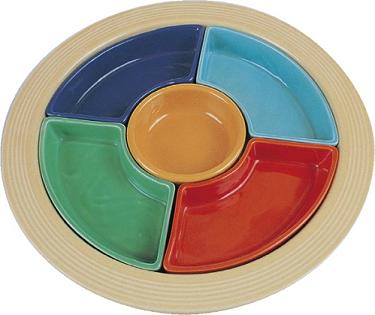 Mark F. Moran 2004 Krause Publications Published by
Mark F. Moran 2004 Krause Publications Published by  700 East State Street Iola, WI 54990-0001
700 East State Street Iola, WI 54990-0001
715-445-2214 888-457-2873
www.krause.com Our toll-free number to place an order or obtain a free catalog is 800-258-0929. All rights reserved. No portion of this publication may be reproduced or transmitted in any form or by any means, electronic or mechanical, including photocopy, recording, or any information storage and retrieval system, without permission in writing from the publisher, except by a reviewer who may quote brief passages in a critical article or review to be printed in a magazine or newspaper, or electronically transmitted on radio or television. Library of Congress Catalog Number: 2003112547 ISBN: 0-87349-751-1
eISBN: 978-1-44022-609-0 Designed by Donna Mummery
Edited by Dennis Thornton Printed in USA Words of thanks
This book would not have been possible without the assistance and good wishes of many people, including:
Jim and Jan Van Hoven, Bill and Sliv Carlson, Fred Mutchler, Marv and Deb McNuss, and Ed and Carol Peek. Contents
Bowls
Covered onion bowl Candleholders
Bulb candleholder Casseroles
Covered casserole Coffeepots
Coffeepot Comports
Comport Creamers
Creamer, sugar, tray set Cups
Egg cup Mugs
Tom & Jerry mug Pitchers
Disk juice pitcher Plates
6" plate Platters
Oval platter Teapots
Medium teapot Trays
Relish tray Tumblers
Juice tumbler Vases
Bud vase Amberstone, Casuals, Casualstone,
Ironstone On the Road to Fiesta The Homer Laughlin China Company originated with a two-kiln pottery on the banks of the Ohio River in East Liverpool, Ohio.
Built in 1873-74 by Homer Laughlin and his brother, Shakespeare, the firm was first known as the Ohio Valley Pottery, and later Laughlin Bros. Pottery. It was one of the first white-ware plants in the country. 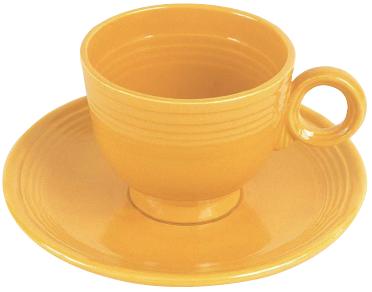 After a tentative beginning, the company was awarded a prize for having the best white-ware at the 1876 Centennial Exposition in Philadelphia. Under new ownership in 1907, the headquarters and a new 30-kiln plant were built across the Ohio River in Newell, W.Va., the present manufacturing and headquarters location. Dr. Albert V. Albert V.
After a tentative beginning, the company was awarded a prize for having the best white-ware at the 1876 Centennial Exposition in Philadelphia. Under new ownership in 1907, the headquarters and a new 30-kiln plant were built across the Ohio River in Newell, W.Va., the present manufacturing and headquarters location. Dr. Albert V. Albert V.
Bleininger was hired in 1920. A scientist, author, and educator, he oversaw the conversion from bottle kilns to the more efficient tunnel kilns. In 1927, the company hired designer Frederick Hurten Rhead. A member of a distinguished family of English ceramists, Rhead began to develop the artistic quality of the companys wares, and to experiment with shapes and glazes. In 1935, this work culminated in his designs for the Fiesta line. Fiesta colors and years of production up to 1972 Antique Gold dark butterscotch
(1969-1972) Chartreuseyellowish green
(1951-1959) Cobalt Blue dark or royal blue
(1936-1951) Forest Green dark hunter green
(1951-1959) Graylight or ash gray
(1951-1959) Greenoften called Light Green when comparing it to other green glazes, also called original green
(1936-1951) Ivorycreamy, slightly yellowed
(1936-1951) Mango Red same as original red
(1970-1972) Medium Greenbright rich green
(1959-1969) Redreddish orange
(1936-1944 and 1959-1972) Rosedusty, dark rose
(1951-1959) Turf Greenolive
(1969-1972) Turquoisesky blue, like the stone
(1937-1969) Yellowgolden yellow
(1936-1969) Fiesta Colors Fiesta wares were produced in 14 colors (other than special promotions) from 1936 to 1972.
These are usually divided into the original colors of Cobalt Blue, Green, Ivory, Red, Turquoise, and Yellow (Cobalt Blue, Green, Red, and Yellow only on the Kitchen Kraft line, introduced in 1939); the Fifties colors of Chartreuse, Forest Green, Gray, Medium Green, and Rose; plus the later additions of Casuals, Amberstone, Fiesta Ironstone, and Casualstone (Coventry) in Antique Gold, Mango Red, and Turf Green; and the Striped, Decal, and Lustre pieces. No Fiesta was produced from 1973 to 1985. The colors that make up the original and Fifties groups are sometimes referred to as the standard eleven. In many pieces, Medium Green is the hardest to find and most expensive Fiesta color. The Red Scare During World War II, the U.S. government restricted the use of uranium oxide, which gave Fiesta Red its color.
This restriction was not lifted until 1959. Though the company then used a different formulation for the Red glaze, people were still concerned about vintage glazes with even a minute uranium or heavy metal content. The Food and Drug Administration had previously determined that daily use of vintage dinnerware as serving pieces does not pose a hazard, as long as the glazes and decals were properly applied. To be on the safe side, avoid storing food in any vintage pieces, and do not use them in a microwave oven. Dimensions and Colors Even though we have provided detailed dimensions for each Fiesta piece, the nature of the machinery used to make each item, and the skill of the potters who applied some details by hand, result in variations throughout the line. Some glazes also have several shades, to the point that even seasoned collectors and antique dealers may mistake an especially heavy Light Green glaze for the more rare Medium Green.
Some glazes are also prone to mottling, including Turquoise andto a lesser degreeRed. Cobalt Blue and Turf Green pieces tend to show even the slightest scratches more obviously than lighter glazes, and Ivory examples often exhibit cloudy or sooty spots along rims and bases. And remember that Fiesta colors will also look different depending on the light at hand. Incandescent, fluorescent, and natural light will each add a different color element. 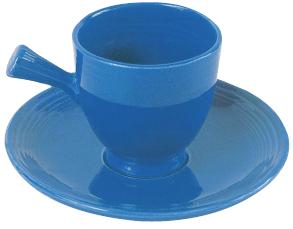 Some bottom marks
Some bottom marks 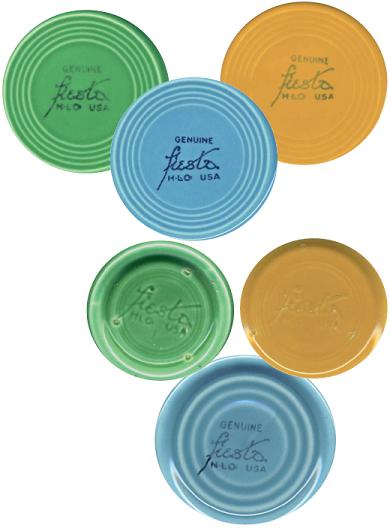 Bottom of 6" bread plates in Green, Turquoise, and Yellow, showing Genuine Fiesta stamp. 1 mixing bowl in Green, showing sagger pin marks, the Fiesta/HLCo. 1 mixing bowl in Green, showing sagger pin marks, the Fiesta/HLCo.
Bottom of 6" bread plates in Green, Turquoise, and Yellow, showing Genuine Fiesta stamp. 1 mixing bowl in Green, showing sagger pin marks, the Fiesta/HLCo. 1 mixing bowl in Green, showing sagger pin marks, the Fiesta/HLCo.
USA impressed mark, and the faint 1 size indicator. The impressed size mark on the bottom of the No. 2 mixing bowl in Yellow is too faint to be seen in this image. Bottom of a teacup saucer in Turquoise, showing the Genuine Fiesta stamp. Note the difference in the ring pattern when compared to the Turquoise bread plate.
Dimensions: 6 1/4" by 1 1/4".
Dimensions: 6 1/4" by 1 1/4".
Introduced in 1936, and produced through the late 1960s, possibly as late as mid-1969. There are two bottom variations known. Before 1940, the base has seven rings; after 1940, the base has two rings and a Genuine Fiesta stamp. Production of Red examples was halted in 1944 and resumed in 1959. Degree of Difficulty: 1 for all colors other than Medium

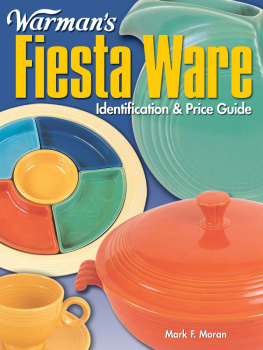
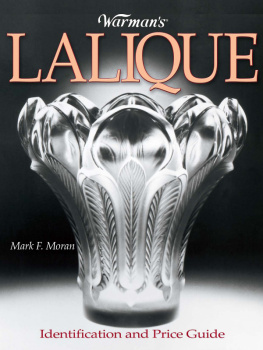
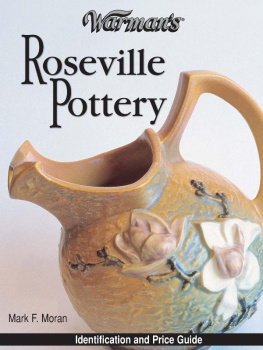
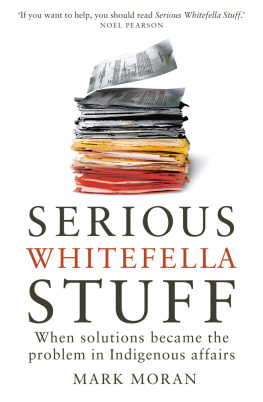

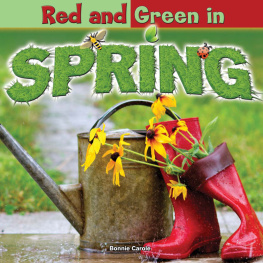
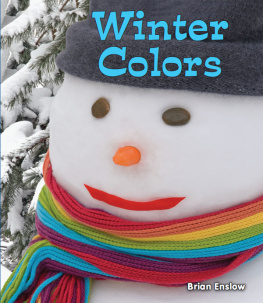

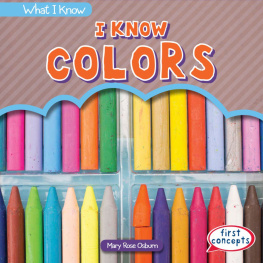

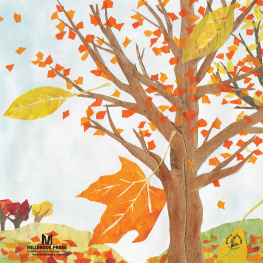
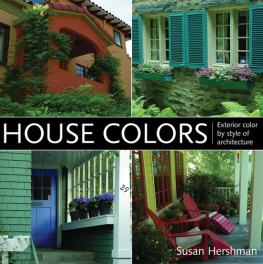
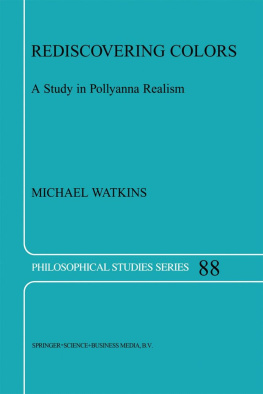
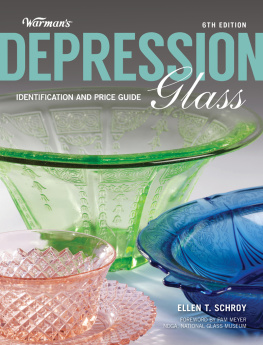
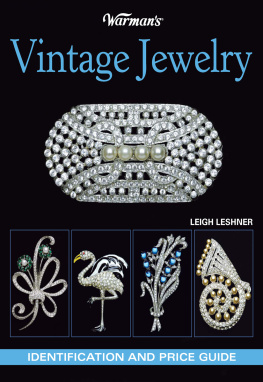
 Warmans Fiesta Ware Identification and Price Guide
Warmans Fiesta Ware Identification and Price Guide  Mark F. Moran 2004 Krause Publications Published by
Mark F. Moran 2004 Krause Publications Published by  700 East State Street Iola, WI 54990-0001
700 East State Street Iola, WI 54990-0001 After a tentative beginning, the company was awarded a prize for having the best white-ware at the 1876 Centennial Exposition in Philadelphia. Under new ownership in 1907, the headquarters and a new 30-kiln plant were built across the Ohio River in Newell, W.Va., the present manufacturing and headquarters location. Dr. Albert V. Albert V.
After a tentative beginning, the company was awarded a prize for having the best white-ware at the 1876 Centennial Exposition in Philadelphia. Under new ownership in 1907, the headquarters and a new 30-kiln plant were built across the Ohio River in Newell, W.Va., the present manufacturing and headquarters location. Dr. Albert V. Albert V. Some bottom marks
Some bottom marks  Bottom of 6" bread plates in Green, Turquoise, and Yellow, showing Genuine Fiesta stamp. 1 mixing bowl in Green, showing sagger pin marks, the Fiesta/HLCo. 1 mixing bowl in Green, showing sagger pin marks, the Fiesta/HLCo.
Bottom of 6" bread plates in Green, Turquoise, and Yellow, showing Genuine Fiesta stamp. 1 mixing bowl in Green, showing sagger pin marks, the Fiesta/HLCo. 1 mixing bowl in Green, showing sagger pin marks, the Fiesta/HLCo.